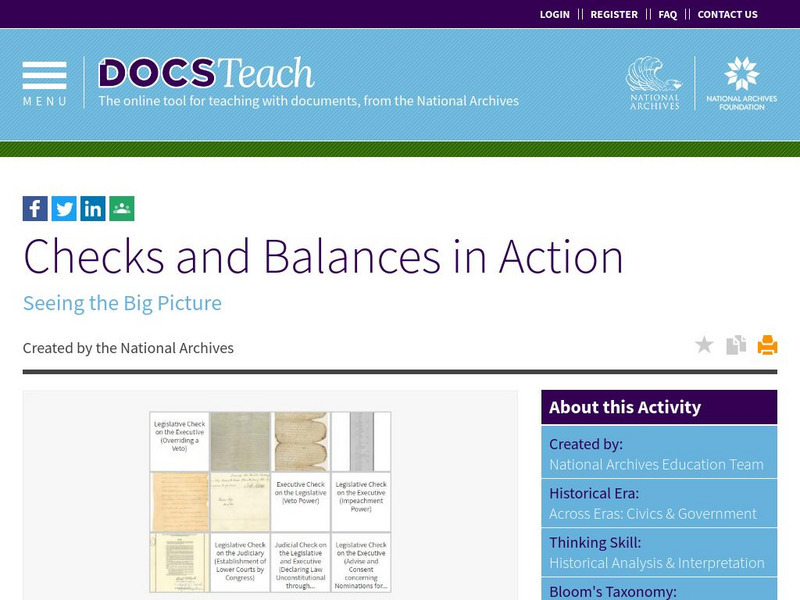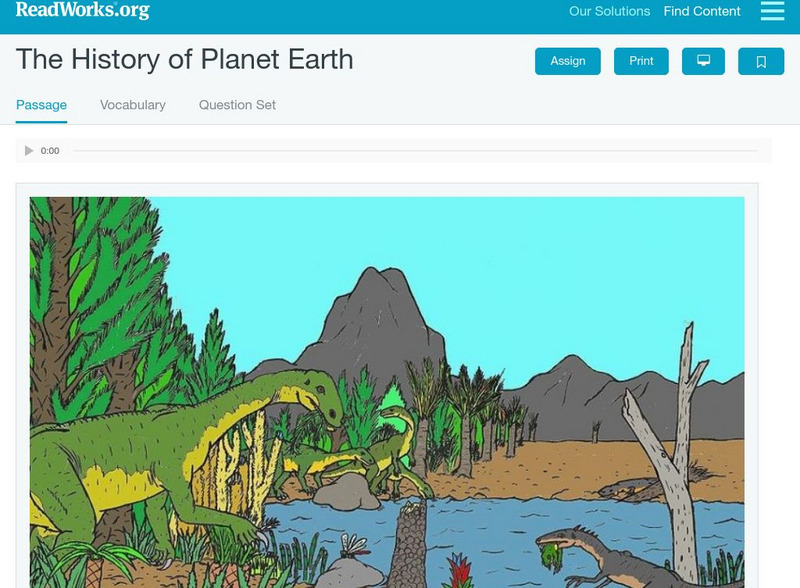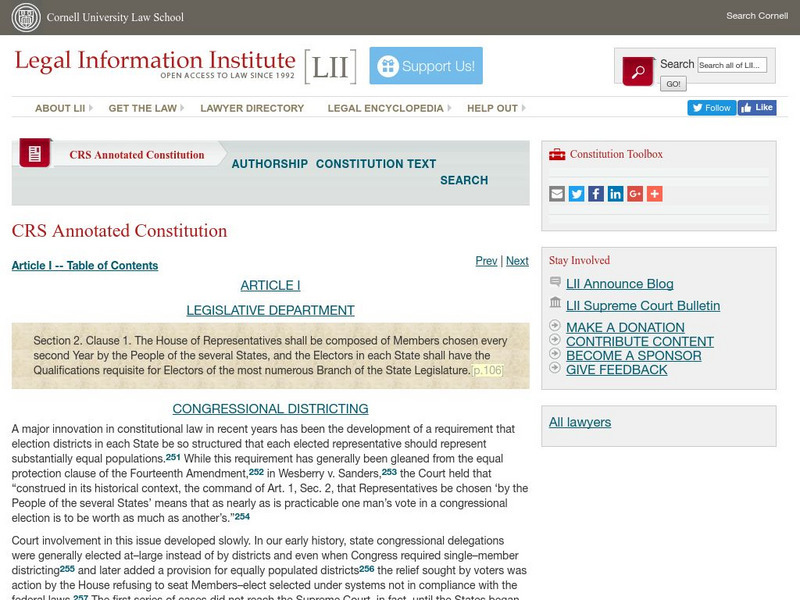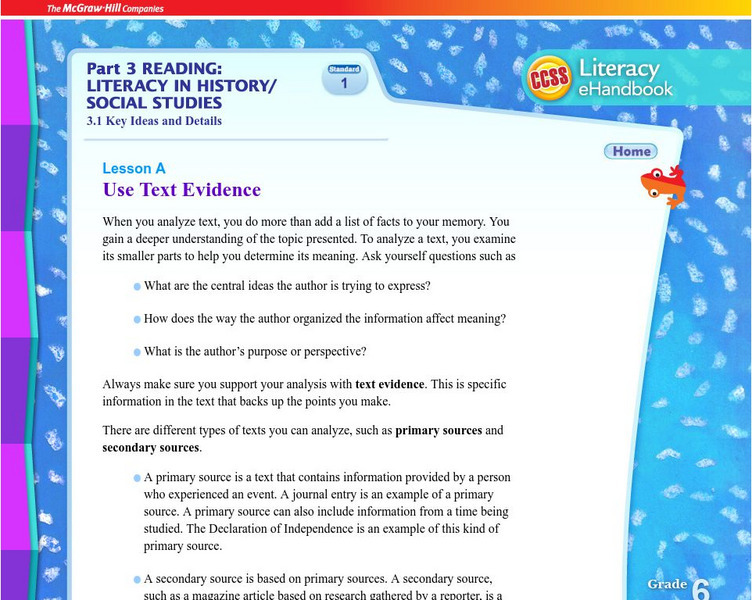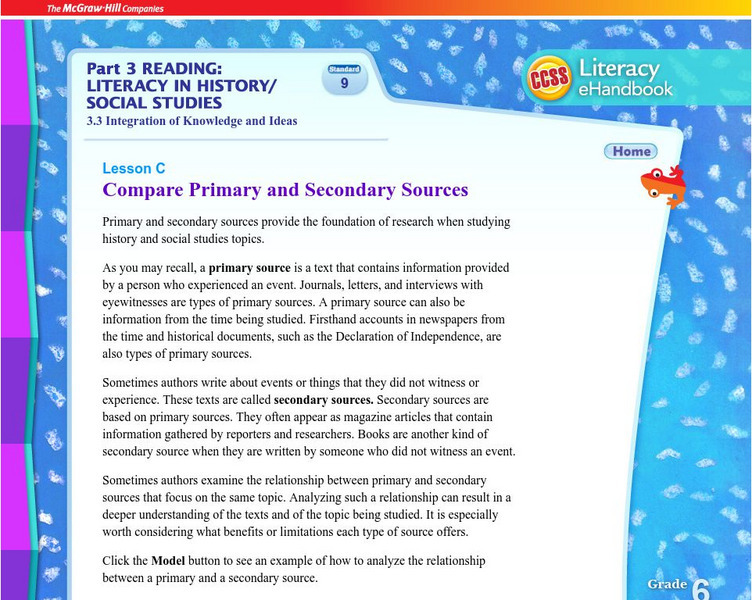US National Archives
Docs Teach: Checks and Balances in Action
In this activity, students will analyze documents that span the course of American history to see examples of 'checks and balances' between the legislative, executive, and judicial branches in action. Students will then match the...
US National Archives
Docs Teach: Separation of Powers or Shared Powers
In this activity, learners will analyze documents that illustrate the relationship between the legislative, executive and judicial branches. Using the scale in Weighing the Evidence, students will decide whether the United States...
TES Global
Tes: Determining of Credibility of Online Sources
[Free Registration/Login Required] This free resource is a sheet that will help students assess the credibility of an online primary source or an online secondary source.
Read Works
Read Works: See if I Care
[Free Registration/Login Required] A literary text about a newspaper editor who is tricked into following a false lead. A question sheet is available to help students build skills in reading comprehension.
Read Works
Read Works: Fuels of the Future
[Free Registration/Login Required] Students read about renewable energy sources that may replace fossil fuel in the future. A question sheet is available to help students build skills in comparing and contrasting.
Read Works
Read Works: The History of Planet Earth
[Free Registration/Login Required] This informational text passage shares information about the history of the earth and its landforms. This passage is a stand-alone curricular piece that reinforces essential reading skills and...
Sophia Learning
Sophia: How to Choose Credible Sources
This tutorial focuses on choosing credible sources for a research project. It offers two versions of a slideshow: a non-audio slideshow and an audio slideshow which explains the information as it is shown. They each define terms, offer...
Sophia Learning
Sophia: Research Sources: Books
A nine-slide presentation discussing the pros and cons of books being used during the process of gathering research.
Discovery Education
Discovery Education: Your Daily Learning Platform
An index to the Discovery Channel. Find resources for teachers, students, and even parents, from science experiments to math help, to virtual field trips.
Cornell University
Cornell University: Law School: Annotated Constitution: Article I
Commentary on the development over time of congressional districting, based on Article I, Section 2, Clause 1 of the Constitution.
Other
Society of Professional Journalists: Freedom of Info.
This resource is a great tool for journalists and non-journalists to obtain information from federal and local government sources. Access to this information can make or break a news story.
Other
New York State Library: Student Activity: Primary Versus Secondary Sources
Read about the Railroad Strike of 1877 using three excerpts from textbooks and three original newspaper articles. Compare and contrast the information in the primary and secondary sources.
Sophia Learning
Sophia: In Text Citations: Lesson 6
This lesson introduces in-text citations and how to embed them in text. It is 6 of 7 in the series titled "In-Text Citations." W.9-10.8 Sources
Education Development Center
Education Development Center: Tv411: Parts of a Newspaper
Students click through a lesson about the parts of a newspaper and answer questions about the types of articles found in each section, headlines, and captions that would go with photographs. Links to related videos are also provided.
Education Development Center
Tv411: Reading: Parts of a Newspaper
A series of three activities help readers become familiar with parts of a newspaper, from sections to headlines and captions.
Online Writing Lab at Purdue University
Purdue University Owl: Types of Sources
A list and explanation of different types of print and online sources. W.11-12.8 Sources/Integrate/Cite
Online Writing Lab at Purdue University
Purdue University Owl: Common Pitfalls of Primary Research
Learn about the common mistakes made when reporting primary research findings.
iCivics
I Civics: Three Branches: Laws in Action
Embark on his WebQuest to follow the path an idea takes to eventually become a law. Read a short description regarding the role of each branch of government and then answer a follow-up question using the link provided.
Curated OER
Mc Graw Hill: Key Ideas and Details: Use Text Evidence
Learn how to analyze primary and secondary sources using text evidence. An example is provided. (Note: Exercises don't load in archived copy.)
Library of Congress
Loc: Sourcing a Document: The First Thanksgiving
In this activity, students discuss the reliability of a painting of the First Thanksgiving to introduce the idea that is crucial to consider a source's date.
Curated OER
Mc Graw Hill: Compare Primary and Secondary Sources
Learn how to analyze and compare the relationship between a primary and a secondary source.
US Government Publishing Office
Ben's Guide to u.s. Government: Learning Adventures: Branches of Government
Introduction to a learning adventure on the Constitution and branches of government. Students click on their age group icon to find information on which part of the Constitution spells out the powers of legislative, executive and...
US Government Publishing Office
Ben's Guide to u.s. Government: Judicial Branch (6 8)
This site from Ben's Guide to U.S. Government provides a brief overview of the judicial branch of the federal government. Discusses the origin of the judicial branch, the concept of judicial review, and functions of the judicial branch....
The Dirksen Congressional Center
Congress for Kids: The Legislative Branch: Making Laws
Discover how laws are made in the United States, and then complete the trivia questions as a follow-up activity.


